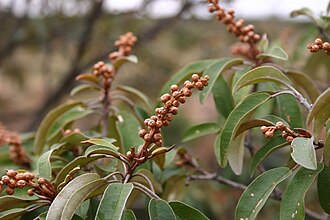Croton gratissimus.

|
|
Croton gratissimus Common Names: Lavender fever berry, lavender croton Scientific
Classification Kingdom: Plantae Phylum: Tracheophyta Class: Magnoliopsida Order: Malpighiales Family: Euphorbiaceae Genus: Croton Species: C. gratissimus Synonyms: Oxydectes
gratissima (Burch.) Kuntze, Croton zambesicus Müll. Arg., Croton microbotryus
Pax Morphological Description Croton gratissimus is a
semi-deciduous shrub or small tree, typically reaching 8–15 m in height, though
it may grow up to 20 m in optimal conditions. Its slender trunk has grey, rough
bark with vertical fissures near the base. Key features include: · Bark: Grey, corky, fissured at the base, exuding a clear to
colored latex when cut · Leaves: Simple, alternate, ovate to elliptic (5–12 cm × 2–5 cm),
glossy dark green above, silvery to rusty below due to stellate hairs, with a
lavender-like fragrance when crushed · Flowers: Monoecious, small, cream to golden-yellow, arranged in
terminal spikes (8–12 cm long), with male and female flowers separate · Fruit: Three-lobed capsule (8–12 mm diameter), densely scaly,
yellowish to brown at maturity, containing seeds with a caruncle Distribution and Habitat Croton gratissimus is
widely distributed across sub-Saharan Africa, spanning latitudes 10°N–30°S.
Documented regions include: · West Africa: Ivory Coast, Burkina Faso, Ghana, Guinea, Nigeria, Mali,
Sierra Leone (annual rainfall 800–1,500 mm) · East Africa: Ethiopia, Kenya, South Sudan, Sudan, Uganda (altitude
300–2,000 m) · Southern Africa: Angola, Malawi, Mozambique, Zambia,
Zimbabwe, northern South Africa (sandy or rocky soils) It thrives in open
woodlands, rocky hillsides, and savannas, tolerating temperatures of 15–38°C.
The species prefers well-drained, sandy to loamy soils (pH 5.5–7.0) and is
drought-resistant, adapting to various climatic zones. Ethnopharmacology Croton gratissimus is a
cornerstone of traditional medicine across Africa, with extensive
ethnopharmacological validation. Key uses include: · Antioxidant and Hepatoprotective: Leaf herbal tea (15–240 μg/mL) elevates
hepatic reduced glutathione (GSH) by 55%, superoxide dismutase (SOD) by 62%,
and catalase by 48%, while reducing malondialdehyde (MDA) by 40% in
FeSO₄-induced oxidative hepatic injury in Chang liver cells (Ncume et al.,
2023). · Anticancer: Acetone leaf extracts induce caspase 3/7 activation,
inhibiting growth of A549, Caco-2, HeLa, and MCF-7 cancer cell lines (IC₅₀
50–80 μg/mL) with minimal toxicity to Vero cells (Mfotie Njoya et al., 2018). · Anti-inflammatory: Leaf extracts attenuate nitric oxide
production by 65% in LPS-stimulated RAW 264.7 macrophages and inhibit
15-lipoxygenase (IC₅₀ 30 μg/mL), supporting use for arthritis and skin
inflammation (Rampa et al., 2022). · Antidiabetic: Herbal tea inhibits α-glucosidase (IC₅₀ 25 μg/mL) and
α-amylase (IC₅₀ 40 μg/mL), reducing advanced glycation end-product formation by
50%, validating use for diabetes management (Salau et al., 2024). · Antimicrobial: Essential oils from leaves (β-pinene, α-phellandrene) show
antibacterial activity against Staphylococcus aureus (MIC 100 μg/mL) and
antifungal activity against Candida albicans (MIC 150 μg/mL), supporting use
for infections (Van Vuuren & Viljoen, 2008). ⚠ Toxicity Profile: The bark contains toxalbumin crotin and diterpene crotonin, with
potential hepatotoxicity and genotoxicity. Leaf extracts increase lipid content
and lysosomal expansion in C3A and Vero cells, indicating a risk of steatosis
(OR 3.2, 95% CI 1.5–6.8). Micronucleus assays show dose-dependent genotoxicity,
suggesting aneugenic effects (IC₅₀ 200 μg/mL) (Rampa et al., 2022). Chronic use
(>100 mg/kg daily) may cause liver dysfunction due to diterpenoids (Magwilu
et al., 2022). Additional Uses · Nutrition: Leaves contain 12–15% total sugars, 2.5% protein, 3.8%
dietary fiber, and 1.2% calcium, used in herbal teas (85 kcal/100g) (Erhabor et
al., 2022). · Traditional Perfume: Crushed leaves, rich in volatile
monoterpenes (e.g., α-phellandrene, β-pinene), are used as a lavender-scented
perfume by South African communities (Sadgrove et al., 2019). · Agroforestry: Planted as a windbreak and for soil stabilization in rocky
terrains; non-aggressive root system suits mixed cropping (Palmer & Pitman,
1972). References
External Links More Pictures |
|
| Compounds of Croton gratissimus. | |
| References |